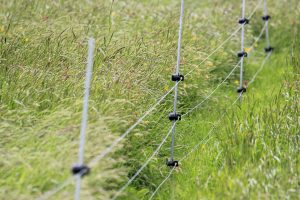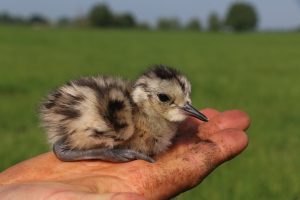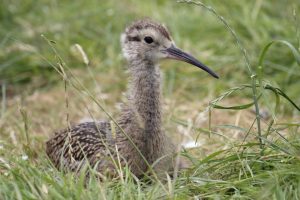Blog by Amanda Perkins, Project Manager
 I have just been chatting to Tim, one of our small team who takes much responsibility for maintaining the fence and camera batteries. You may sometimes hear the regular strimming, which is necessary to stop the fence from shorting out. Sometimes Tim is so adept that the incubating bird does not move from the nest and he was recently dubbed a Ninja by his colleague. Tim told me that he can hardly bear to watch the live streaming in case anything goes awry (apologies for the brief website failure due to an automatic renewal which failed). When the first live stream Curlew Cam went up in 2017, I was so alarmed to hear the noises that the Curlews make during changeovers, wanting them to keep quiet to stop avian predators from being alerted to the presence of the nest. Thankfully, most of the time the quiet soothing background of rural noises forms the soundscape. A supporter contacted me to say that she found the tick tick noise of the electric fence, which can sometimes be heard, most re-assuring in the current crisis.
I have just been chatting to Tim, one of our small team who takes much responsibility for maintaining the fence and camera batteries. You may sometimes hear the regular strimming, which is necessary to stop the fence from shorting out. Sometimes Tim is so adept that the incubating bird does not move from the nest and he was recently dubbed a Ninja by his colleague. Tim told me that he can hardly bear to watch the live streaming in case anything goes awry (apologies for the brief website failure due to an automatic renewal which failed). When the first live stream Curlew Cam went up in 2017, I was so alarmed to hear the noises that the Curlews make during changeovers, wanting them to keep quiet to stop avian predators from being alerted to the presence of the nest. Thankfully, most of the time the quiet soothing background of rural noises forms the soundscape. A supporter contacted me to say that she found the tick tick noise of the electric fence, which can sometimes be heard, most re-assuring in the current crisis.
Our fencing trial started in 2016. In 2015 and 2016, Curlew Country monitored over 30 nests, no  chicks fledged from any of those nests. Each year only 3 nests got beyond egg stage to hatch chicks. After the devastating findings of 2015, Andrew Hoodless from the Game and Wildlife Conservation Trust had told me about Natalie Meyer in Germany who worked for NABU, and who had been trialling temporary electric fencing around individual Curlew nests. Whilst electric fencing had been used for some time to protect colonial nesters such as avocets from mammalian predators, it had hitherto been thought of as impractical for territorial nesters like Curlew. Natalie had improved the Curlew egg hatch rate considerably. I contacted her and she gave me the details. Understandably Tony our ornithologist was worried about Curlews flying off the nest into the fence, but in 2016 when there were only 3 nests left, he was willing to take the risk of trialling a Curlew nest fence. Having satisfied himself that the birds were unaffected, the other two remaining nests were quickly fenced as well. The three nests hatched chicks, although sadly no chicks survived.
chicks fledged from any of those nests. Each year only 3 nests got beyond egg stage to hatch chicks. After the devastating findings of 2015, Andrew Hoodless from the Game and Wildlife Conservation Trust had told me about Natalie Meyer in Germany who worked for NABU, and who had been trialling temporary electric fencing around individual Curlew nests. Whilst electric fencing had been used for some time to protect colonial nesters such as avocets from mammalian predators, it had hitherto been thought of as impractical for territorial nesters like Curlew. Natalie had improved the Curlew egg hatch rate considerably. I contacted her and she gave me the details. Understandably Tony our ornithologist was worried about Curlews flying off the nest into the fence, but in 2016 when there were only 3 nests left, he was willing to take the risk of trialling a Curlew nest fence. Having satisfied himself that the birds were unaffected, the other two remaining nests were quickly fenced as well. The three nests hatched chicks, although sadly no chicks survived.
A temporary electric fence will protect against all but the most determined mammalian predators. It will protect against accidental agricultural destruction and livestock trampling. Fences must be maintained to stop contact with vegetation to prevent them from shorting out. The batteries also need changing and charging.
 After two thoroughly depressing years we stopped monitoring the causes of decline and started intervening to try and make a real difference to the survival of breeding Curlews. In 2017 we put up as many temporary electric fences as possible. We worked with farmers to assess the real costs to them of sustaining loss of crop to enable breeding Curlew success and supporting them accordingly where possible. We trialled predation control in 3 areas. We obtained the first UK licence from Natural England to headstart Curlew. This meant we could incubate eggs and return them to the nests when they were just about to hatch (at pip stage) as we needed to test what would happen to the chicks. At least three chicks survived to fully fledge, including one from our Curlew Cam territory but not without incident (please see our blog here).
After two thoroughly depressing years we stopped monitoring the causes of decline and started intervening to try and make a real difference to the survival of breeding Curlews. In 2017 we put up as many temporary electric fences as possible. We worked with farmers to assess the real costs to them of sustaining loss of crop to enable breeding Curlew success and supporting them accordingly where possible. We trialled predation control in 3 areas. We obtained the first UK licence from Natural England to headstart Curlew. This meant we could incubate eggs and return them to the nests when they were just about to hatch (at pip stage) as we needed to test what would happen to the chicks. At least three chicks survived to fully fledge, including one from our Curlew Cam territory but not without incident (please see our blog here).
Many lessons were learned quickly. The only chicks which survived were from nests actively ![]() supported by farmers, who sustained crop losses to enable chicks to fledge and where there was also active lethal fox control. The sums needed to cover the loss of crops were not covered by the existing agri-environment schemes and were too large for a small farm business to sustain. The predation control also needed funding to be effective and done properly. The fences, which we had been rather excited about, considerably increased the egg to hatch rate, but without support to farmers for loss of crop and lethal fox control the resulting chicks were soon lost. We also learned that the fences attracted predatory crows which had hitherto not been so much of a problem in our area. When the area around a nest is tightly mown or grazed the long grass is instinctively attractive to predators. If nearby agricultural activity such as mowing takes place the Curlew are disturbed off the nest in alarm, giving the nest location away. Natalie Meyer at NABU was also finding that whilst the fencing was helping hatch rates and some fledging rates it was not enough to sustain a local population. Curlew Country now recommends caution in respect of temporary electric fencing around Curlew nests. With limited resources to spend on Curlew Recovery, spending this on fences when it is known that without other measures chicks are unlikely to fully fledge, (if the corvids allow them to get that far), raises hopes and usually dashes them again when the chicks hatch. The use of temporary electric fences can be an effective measure to increase egg productivity but will not by itself enable Curlew to breed sustainably. The tick tick sound is re-assuredly protective but not the environment beyond.
supported by farmers, who sustained crop losses to enable chicks to fledge and where there was also active lethal fox control. The sums needed to cover the loss of crops were not covered by the existing agri-environment schemes and were too large for a small farm business to sustain. The predation control also needed funding to be effective and done properly. The fences, which we had been rather excited about, considerably increased the egg to hatch rate, but without support to farmers for loss of crop and lethal fox control the resulting chicks were soon lost. We also learned that the fences attracted predatory crows which had hitherto not been so much of a problem in our area. When the area around a nest is tightly mown or grazed the long grass is instinctively attractive to predators. If nearby agricultural activity such as mowing takes place the Curlew are disturbed off the nest in alarm, giving the nest location away. Natalie Meyer at NABU was also finding that whilst the fencing was helping hatch rates and some fledging rates it was not enough to sustain a local population. Curlew Country now recommends caution in respect of temporary electric fencing around Curlew nests. With limited resources to spend on Curlew Recovery, spending this on fences when it is known that without other measures chicks are unlikely to fully fledge, (if the corvids allow them to get that far), raises hopes and usually dashes them again when the chicks hatch. The use of temporary electric fences can be an effective measure to increase egg productivity but will not by itself enable Curlew to breed sustainably. The tick tick sound is re-assuredly protective but not the environment beyond.
 More desperation followed the hard and fast feedback from trialling in 2017. Without funding for wide farmer support and predation control, the local Curlew population remained under threat. We had been obliged to rear 6 chicks with no nests to return them to (they had all been predated by that stage) in 2017. We knew it could be done so we made the decision to headstart more comprehensively in 2018 – take eggs from nests, hatch and rear the chicks and release them back into their natural landscape. There was limited information available. No-one had headstarted Curlew chicks in the UK, but we had nothing to lose. Nothing could be worse than 0 fledged chicks which was inevitable without the requisite farmer support and predation control. Amber and I spent long anxious days adjusting eggs and incubators, then feeding chicks and cleaning their pens and equipment. Our charges were so precious and the very few chick losses suffered were still too many for us. When 21 chicks took to foraging naturally and then to the air, following release from their rearing pen, the Curlew Country team and its key supporters, invited to watch from a distance, tried to cover up the odd tear in the eye.
More desperation followed the hard and fast feedback from trialling in 2017. Without funding for wide farmer support and predation control, the local Curlew population remained under threat. We had been obliged to rear 6 chicks with no nests to return them to (they had all been predated by that stage) in 2017. We knew it could be done so we made the decision to headstart more comprehensively in 2018 – take eggs from nests, hatch and rear the chicks and release them back into their natural landscape. There was limited information available. No-one had headstarted Curlew chicks in the UK, but we had nothing to lose. Nothing could be worse than 0 fledged chicks which was inevitable without the requisite farmer support and predation control. Amber and I spent long anxious days adjusting eggs and incubators, then feeding chicks and cleaning their pens and equipment. Our charges were so precious and the very few chick losses suffered were still too many for us. When 21 chicks took to foraging naturally and then to the air, following release from their rearing pen, the Curlew Country team and its key supporters, invited to watch from a distance, tried to cover up the odd tear in the eye.
In 2019, The Wildfowl and Wetlands Trust (WWT) became partners for what we both knew was likely for funding reasons to be (and they have called) a ‘one-year stand’. Chester Zoo complemented their input by sending a member of staff to help on the demanding rota. The new team meshed superbly. WWT were great partners bringing us their avicultural expertise and much improved equipment. We imparted our Curlew knowledge and experience beyond just headstarting. The egg to hatch rate increased dramatically with improved techniques and equipment. 33 chicks were released.
for funding reasons to be (and they have called) a ‘one-year stand’. Chester Zoo complemented their input by sending a member of staff to help on the demanding rota. The new team meshed superbly. WWT were great partners bringing us their avicultural expertise and much improved equipment. We imparted our Curlew knowledge and experience beyond just headstarting. The egg to hatch rate increased dramatically with improved techniques and equipment. 33 chicks were released.
The five-year chick tally was 0 chicks from natural nests in 2015 and 2016 and about 3 from natural nests where farmer support for habitat management and predation control were in place on each of the following three years. 60 head-started chicks were released in those same three years.
 Like fences, headstarting alone will not recover Curlews. Recovery and sustainability can only be achieved with additional land management measures. Unlike fencing, it will prevent our population from dying out now.
Like fences, headstarting alone will not recover Curlews. Recovery and sustainability can only be achieved with additional land management measures. Unlike fencing, it will prevent our population from dying out now.
Thank you to all the people who have sent messages and donations from close, far, and wide. I am glad you are enjoying our Curlew Cam across the UK and in Europe, America, Abu Dhabi and even in virtual conferences, when you probably should not be, but we are glad you are. Curlews are charismatic and precious to many of us. We need to ensure that our Curlews will thrive into the future, not just with extreme interventions to save them now. With your help we can achieve this.
[paypal_donation_button]

